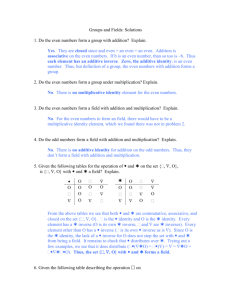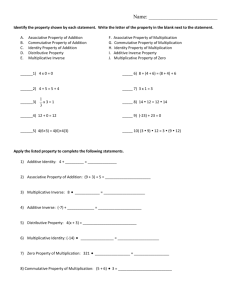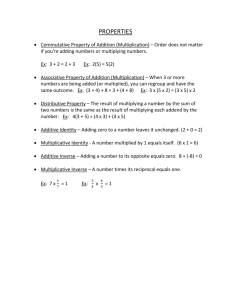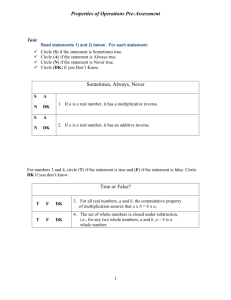Monday 10-19-15 - Class Assignment - Properties
advertisement
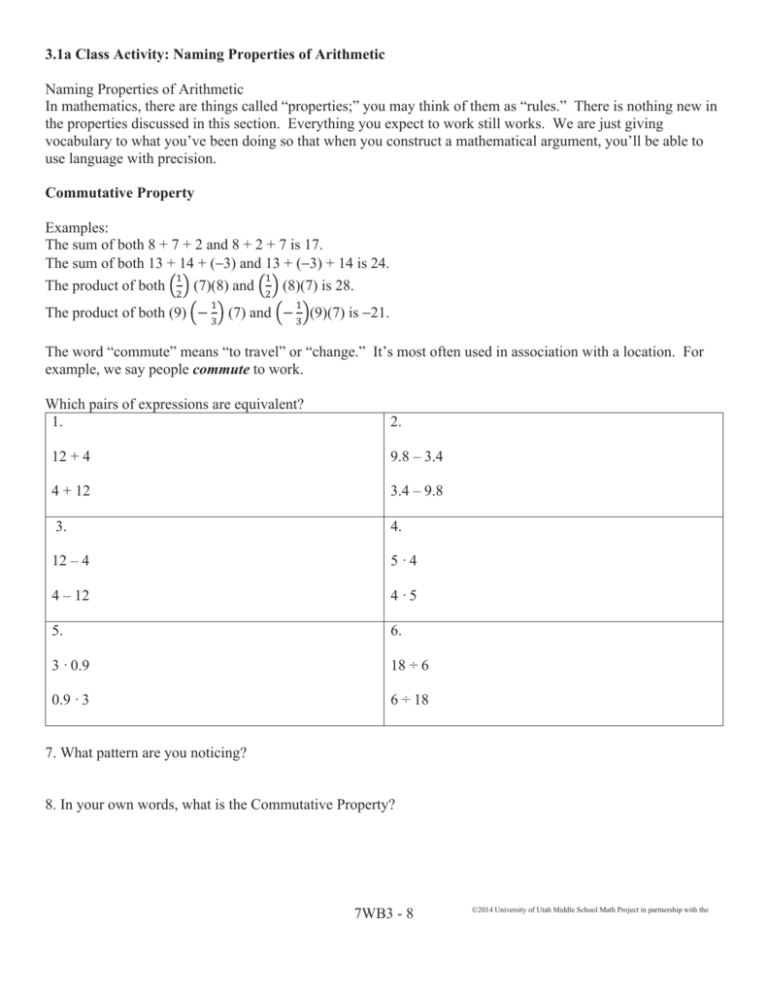
3.1a Class Activity: Naming Properties of Arithmetic Naming Properties of Arithmetic In mathematics, there are things called “properties;” you may think of them as “rules.” There is nothing new in the properties discussed in this section. Everything you expect to work still works. We are just giving vocabulary to what you’ve been doing so that when you construct a mathematical argument, you’ll be able to use language with precision. Commutative Property Examples: The sum of both 8 + 7 + 2 and 8 + 2 + 7 is 17. The sum of both 13 + 14 + (−3) and 13 + (−3) + 14 is 24. The product of both (7)(8) and (8)(7) is 28. The product of both (9) (7) and (9)(7) is −21. The word “commute” means “to travel” or “change.” It’s most often used in association with a location. For example, we say people commute to work. Which pairs of expressions are equivalent? 1. 2. 12 + 4 9.8 – 3.4 4 + 12 3.4 – 9.8 3. 4. 12 – 4 5·4 4 – 12 4·5 5. 6. 3 · 0.9 18 ÷ 6 0.9 · 3 6 ÷ 18 7. What pattern are you noticing? 8. In your own words, what is the Commutative Property? 7WB3 - 8 ©2014 University of Utah Middle School Math Project in partnership with the Associative Property The word “associate” means “partner” or “connect.” Most often we use the word to describe groups. For example, if a person goes to Eastmont Middle School and not Indian Hills Middle School, we would say that person is associated with Eastmont Middle School. Examples: The sum of both 3 + (17 + 4) + 16 and (3 + 17) + (4 + 16) is 40 The product of both (2×5)(3) and (2)(5×3) is 30 For each of the following pairs of expressions, the operations are the same, but the constants have been associated (grouped) in different ways. Determine if the pairs are equivalent; be able to justify your answer. 9. 10. (12 + 4) + 6 (12 – 4) – 3 12 + (4 + 6) 12 – (4 – 3) 11. 12. (3 + 5) + 7.4 (20.9 – 8) – 2 3 + (5 + 7.4) 13. 20.9 – (8 – 2) 14. (5 · 4) · (18 ÷ 6) ÷ 3 18 ÷ (6 ÷ 3) 15. 16. (6 · 2) · 5 (24 ÷ 12) ÷ 3 6 · (2 · 5) 24 ÷ (12 ÷ 3) 17. What patterns do you notice about the problems that were given? 18. In your own words, what is the Associative Property? . 7WB3 - 9 ©2014 University of Utah Middle School Math Project in partnership with the Identity Property The word “identity” has to do with “sameness.” We use this word when we recognize the sameness between things. For example, you might say that a Halloween costume cannot really hide a person’s true identity. Above we defined the Associative and Commutative Properties for both addition and multiplication. We need to do the same thing for the Identity Property. 19. What do you think the Identity Property for Addition should mean? 20. Give examples of what you mean: 21. In your own words, what is the Identity Property of Addition? 22. What do you think the Identity Property for Multiplication should mean? 23. Give examples of what you mean: 24. In your own words, what is the Identity Property of Multiplication: 7WB3 - 10 ©2014 University of Utah Middle School Math Project in partnership with the Inverse Properties The word “inverse” means “opposite” or “reverse.” You might say, forward is the inverse of backward. There is an inverse for both addition and multiplication. 25. What do you think should be the additive inverse of 3? 26. What do you think would be the additive inverse of –3? 27. What do you think would be the multiplicative inverse of 3? 28. What do you think would be the multiplicative inverse of ? 29. In your own words, what is the Inverse Property of Addition? 30. In your own words, what is Inverse Property of Multiplication? 7WB3 - 11 ©2014 University of Utah Middle School Math Project in partnership with the Generalizing Properties Properties of Mathematics: Name Property Algebraic Statement Identity Property of Addition Meaning Numeric Examples . Identity Property of Multiplication Multiplicative Property of Zero Commutative Property of Addition Commutative Property of Multiplication Associative Property of Addition Associative Property of Multiplication Additive Inverse Multiplicative Inverse 7WB3 - 12 ©2014 University of Utah Middle School Math Project in partnership with the



